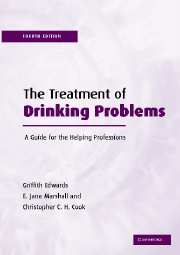Book contents
- Frontmatter
- Contents
- A note on the fourth edition
- Acknowledgements
- Introduction
- Part I Background to understanding
- 1 The history of treatment for drinking problems
- 2 Causes of drinking problems
- 3 Alcohol as a drug
- 4 The alcohol dependence syndrome
- 5 Drinking problems and the family
- 6 Social complications of drinking
- 7 Drinking problems as cause of neuropsychiatric disorders
- 8 Alcohol problems and psychiatric co-morbidity
- 9 Alcohol and other drug problems
- 10 Physical complications of excessive drinking
- 11 Women with drinking problems
- 12 Some special presentations
- 13 Drinking problems and the life course
- Part II Screening, assessment and treatment
- Author index
- Subject index
- References
13 - Drinking problems and the life course
Published online by Cambridge University Press: 11 August 2009
- Frontmatter
- Contents
- A note on the fourth edition
- Acknowledgements
- Introduction
- Part I Background to understanding
- 1 The history of treatment for drinking problems
- 2 Causes of drinking problems
- 3 Alcohol as a drug
- 4 The alcohol dependence syndrome
- 5 Drinking problems and the family
- 6 Social complications of drinking
- 7 Drinking problems as cause of neuropsychiatric disorders
- 8 Alcohol problems and psychiatric co-morbidity
- 9 Alcohol and other drug problems
- 10 Physical complications of excessive drinking
- 11 Women with drinking problems
- 12 Some special presentations
- 13 Drinking problems and the life course
- Part II Screening, assessment and treatment
- Author index
- Subject index
- References
Summary
Meaning can be given to the phrase ‘longitudinal perspective’ through a presentation which took place at a postgraduate teaching forum. At this session, the decision was made to review a bundle of case notes from 20 years previously, and to use this material for discussion around issues of prognosis. A psychiatric registrar (resident) had gone through these notes and summarized the patient's case history as follows.
Mr A was aged 42 at the time of his admission to this hospital 20 years previously. His father had been an army officer, his mother had died young, and his childhood had been loveless and arid. After boarding school, he had been commissioned into his father's regiment and had for a time done well and been decorated for bravery. However, by his mid-thirties, his drinking was becoming notorious and he was faced with the choice of forced discharge or resignation. Back into civilian life and with a wife and two children to support, he went into a security business, which was soon insolvent. By the time of the hospital admission he had severe alcohol dependence and most aspects of his life were in ruin – he was separated from his family, heavily in debt and facing prosecution for financial irregularities. It was unclear whether he had a depressive illness, but he confessed to having at times strong suicidal ruminations and said, ‘I wonder if I've always been depressed’. The last entry in the notes read, ‘Removed from ward today by police on charge of fraud.’
Information
- Type
- Chapter
- Information
- The Treatment of Drinking ProblemsA Guide for the Helping Professions, pp. 203 - 216Publisher: Cambridge University PressPrint publication year: 2003
